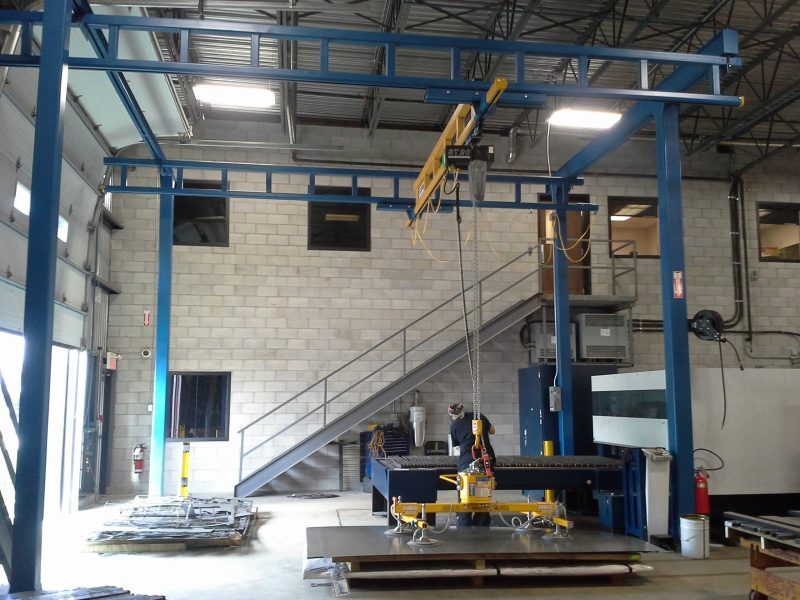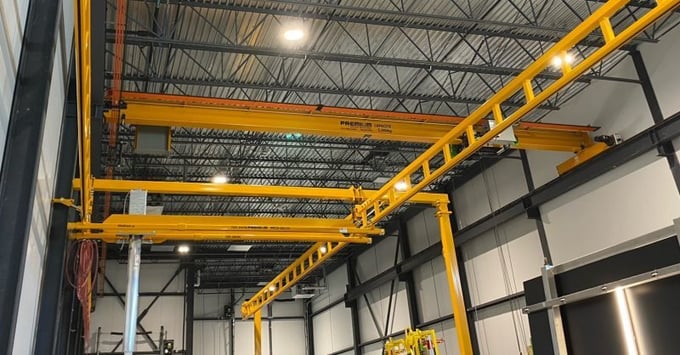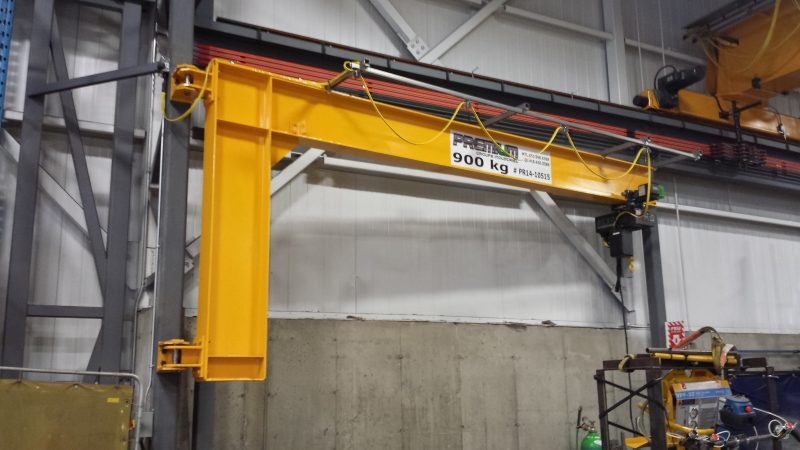-
PRODUCTSreturn
-
SERVICES AND PARTS
-
ABOUT US
What lifting equipment should you choose for lifting light loads?
11:20
In today’s industries, not all loads to be lifted are very heavy. Some may be lighter but still require equipment to move them. But how do you know which is the best equipment for this type of load? For example, there are 3 popular lifting devices for lighter weights: the ergonomic overhead crane, the conventional overhead crane and the jib crane. But which is the best choice? I’ve personally found that buyers sometimes don’t know how to navigate all these options.
Here at Premium Industrial Group, we receive over a hundred requests a year for small-capacity lifting equipment. We’ve installed many of them. That’s why we present here a comparison of the most commonly used lifting devices for light loads :
By the time you’ve finished reading, you’ll have a clear idea of the difference between these types of equipment, as well as their pros and cons. This will enable you to make an informed equipment choice and avoid the disappointment of spending money on the wrong lifting system for your needs.
But first, what is a light load and small-capacity equipment in the context of this article?
What is a small capacity in the industrial overhead crane field?
Obviously, the notion of “light load” or “small capacity” is not the same for everyone. It depends on the type of company. But when we talk about lifting equipment for small capacities in the industrial field, we’re talking about equipment for lifting loads of :
- 250kg minimum
- 2000kg maximum
So, for the purpose of this article, the expressions “light loads” and “small capacities” refer to loads or capacities between 250kg and 2000kg.
Let’s take a look at the 3 different types of equipment that can meet this need, their differences, and their pros and cons. Let’s start with a lesser-known but much-used overhead crane: the ergonomic overhead crane.
1 . The ergonomic overhead crane
The ergonomic overhead crane is a good solution in many situations involving light loads, for example in the following industries or applications:
- Machining shop
- Maintenance workshop
- Mechanical assembly
- Assembly line
They are mainly useful for workstations. For example, they can be used to feed a laser-cutting table, a CNC machine or other similar applications. They are often fitted with lifting accessories, such as suction cups.
But what exactly is an ergonomic crane?
What is an ergonomic overhead crane?
An ergonomic overhead crane is small-scale (width) equipment designed for lifting light loads at workstations. It includes a structure suspended from the ceiling or a freestanding structure lower than a conventional overhead cranes’. In addition, its runways are specially designed to facilitate the manual movement of loads.
Although the hoist is electrically powered, the translational movements (north, south, east, west) are manual, which means you have to push on the load to move it (see “Thrust ratios” box).
Here are some typical features of this type of equipment :
- Maximum capacity : 2000kg
- Maximum span : 30ft
- Maximum height (hook height) : 14ft
- Electric chain hoist
Thrust ratios
The thrust ratio is used to determine the force required to manually move the load. It is 100:1.
For example, to move a 500lb load, you'll need to apply 5lb of thrust.
To comply with this ratio, the overhead crane must have a maximum height of 14ft below the cart.

Ergonomic overhead crane Gorbel = light load
What are the advantages of ergonomic overhead cranes?
- Cost savings
The main advantage of the ergonomic overhead crane is cost reduction. It’s economical because it’s not motorized for horizontal travel. - Versatility
It’s also more versatile, since it’s not as high as a conventional overhead crane. For example, it can be installed under a conventional overhead crane to be dedicated to one application. The freestanding version is also useful when a building is not designed to accommodate a conventional overhead crane structure.

Ergonomic overhead crane under conventional overhead crane
What are the disadvantages of ergonomic overhead cranes?
- Reduced lifting height
The pushing force required to move a load manually increases with height. Above a certain point, the load becomes very difficult to push. This is why lifting height is restricted. - Limited approach distance
The track can be as long as required, but the span of the ergonomic crane is limited to around 30 ft. To move light loads over a greater distance in width, a conventional overhead crane is required.
That said, the freestanding structure of the ergonomic overhead crane can be bulky in certain situations. What to do in such cases? Another option is the jib crane.
2. The jib crane
The jib crane is a piece of equipment designed to move loads in rotation and over small areas. There are different jib cranes for different applications. Some can lift loads of up to 5 tons. However, at this capacity, these devices are often motorized. But what about light loads? Let’s start by defining what a jib crane is, and its typical characteristics for light loads.
What is a jib crane?
This is a lifting device with a horizontal arm attached to a vertical support. Although it can be freestanding, it is very often attached to a building column.
Here are some typical features of this type of equipment, when used for light loads :
- Maximum capacity : 1000kg
- Maximum span : 20ft
- Maximum height (hook height): 16ft
- Motorization : on lift only
- Chain hoist

Wall mounted jib crane
What are the advantages of jib cranes?
- Affordable
The jib crane has a lower acquisition cost than an ergonomic or conventional overhead crane. - Space saving
The wall-mounted jib crane’s compact footprint saves floor space.
What are the disadvantages of jib cranes?
- Reduced approach distance
With a span of around 20ft, this is the option that covers the least surface area. - Limited maneuverability
Because it moves in a circular pattern, the pushing force required increases when handling a load close to the vertical support. In other words, the jib may be more difficult to turn near the hinges.
That said, in certain circumstances, another piece of equipment may be appropriate: the conventional overhead crane.
3. Conventional overhead crane
Conventional overhead cranes are generally used to lift heavier loads, i.e. 2000kg or more. But they may be needed to lift lighter loads for particular applications or situations.
But first, what are we referring to when we say, “conventional overhead crane”?
What is a conventional overhead crane?
A conventional overhead crane runs on a crane runway installed at height on a structure attached to the building, freestanding or semi-freestanding.
img { display: block; margin-left: auto; margin-right: auto; max-width: 100%; height: auto; }
Conventional overhead cranes on freestanding structure
The advantages of this type of equipment are related to its different characteristics from the ergonomic crane and the jib crane:
- Lifting heights of over 16ft
- Variable span
- Motorized movements
Still in the context of lifting light loads, here are the pros and cons of conventional overhead cranes :
What are the advantages of conventional overhead cranes for lifting light loads?
- Higher lifting height
If the load needs to be lifted higher than 16ft, it’s more suitable. Or if the load needs to be lifted over a high obstacle, it might be the option to choose. As mentioned above, the higher the load, the harder it is to push manually. - Greater approach distance
The reach of conventional overhead cranes can go well beyond 30ft, which means they can reach more locations. It’s therefore the option that covers the most surface area. - Motorized travel for safety reasons
Some people opt for conventional overhead cranes when they want to prevent operators from being close to the load. Since the travel movements of this equipment are generally motorized, there’s no need to get close to the load to push it manually.
What are the disadvantages of conventional overhead cranes for lifting light loads?
- High prices
Since this overhead crane is normally designed for heavier loads and is motorized, it is the most expensive option.
Let’s put this information together in a table for a quick and comprehensive analysis.
Comparison chart
Here’s a table showing the features of the different types of equipment, giving you a comparative overview at a glance. The information provided in this table is general and considered in the context of lifting light loads.
|
|
Ergonomic overhead crane
|
Jib crane
|
Conventional overhead crane
|
|---|---|---|---|
| Price | $$ | $ | $$$ |
|
Max. Capacity
|
2 000kg | 1 000kg | + de 2 000kg |
|
Lifting height
|
14-16pi
|
14-16pi
|
+ de 16pi
|
|
Span
|
30pi et -
|
20pi et -
|
Variable |
|
Motorization for horizontal travel
|
No | No | Yes |
|
Hoist types
|
Chain | Chain |
Chain or wire rope
|
|
Type of industry
|
Machining shop, maintenance, mechanical assembly, assembly line
|
Diverse | Diverse |
Now that we have a better idea of the possibilities, how do you choose the right device for your needs?
Ergonomic crane vs. conventional overhead crane vs. jib crane: which is best for me?
Which lifting equipment is right for you depends mainly on the application for which it will be used.
For example, if you need to move lightweight parts at low heights and over a limited span, you’ll save a lot with the ergonomic overhead crane.
But if you’re short of space and need to move light parts over a small area, a jib crane may be just what you’re looking for.
And finally, if you need motorization to move your light loads, for example to lift them higher or for safety reasons, or if your operations require you to move these loads more than 30ft in width, the additional investment in a conventional overhead crane may perhaps be justified.
Your choice will be based on the precise details of your industry and application. That’s why expert advice will be really useful…
The ergonomic gantry crane
There's also a lifting device called an ergonomic gantry crane. This is a mobile (wheeled) gantry crane designed for lifting light loads. However, it is used as a temporary installation for infrequent operations where the load does not need to be moved. In fact, its design makes it difficult to move a load, since you have to push on each "leg" of the gantry rather than pushing the load.

Your next step in choosing between an ergonomic crane, a conventional overhead crane or a jib crane
In this article, we’ve established what small-capacity lifting is in the industrial sector. We have determined the characteristics, pros and cons of the 3 main types of equipment that can be used for this type of lifting. This gives you a clear idea of the options available.
After reading this, you have probably made a connection between your operations and a type of equipment that seems better suited to you. But how can you be sure you’re making the right choice?
The best way to approach any lifting project is to clearly assess your needs. A lifting specialist will be able to guide you on what information to gather.
For more information, see the article Need an overhead crane: Where to start? where you’ll quickly find a list of the information you’ll need when talking to your expert.
The Premium team is available to guide you in your search. When you’re ready, don’t hesitate to fill in the form at the bottom of this page. A representative will contact you to help you choose the best lifting solution for your light loads!
Technical representative at Premium Industrial Group inc.
Learning Center
Whether you're an expert or know nothing about cranes, you'll find everything you need to know HERE.





